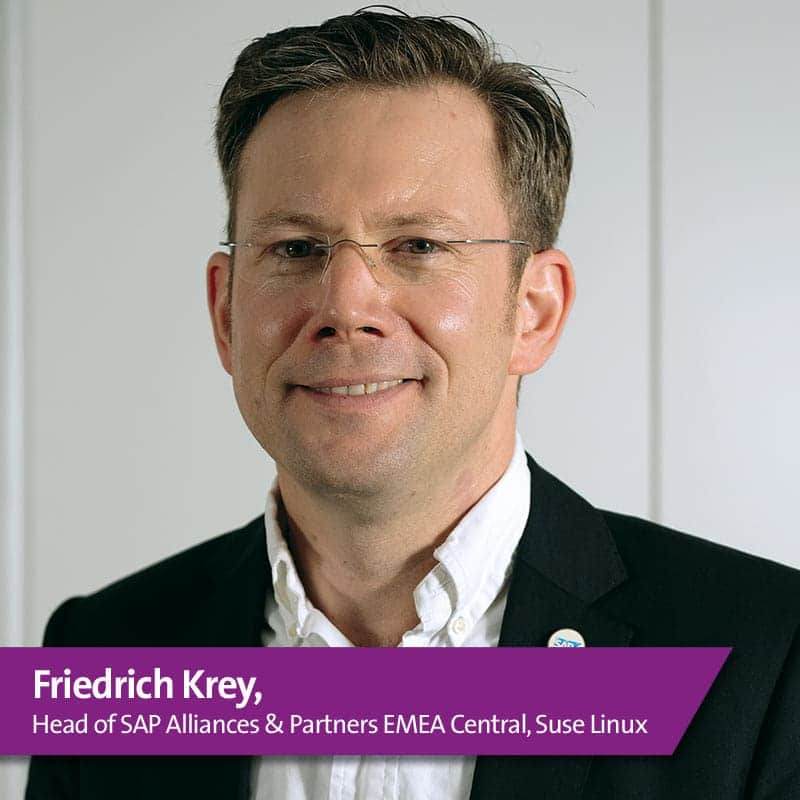Made for hybrid cloud deployment


In the on-premise use of Hana or Hana-based SAP solutions such as S/4, BW/4 or C/4, the Linux open source operating system platform is known to be one of the central system components specified by SAP. Other open source solutions such as Cloud Foundry (PaaS) or OpenStack (IaaS) are also increasingly used or preferred by SAP.
In the context of Linux, Suse Linux Enterprise Server in the "for SAP Applications" version is considered the preferred and recommended OS platform, with a market share of around 95 percent - for which Suse also received the SAP Hana Innovation Award 2017.
The high market penetration is due in particular to the fact that SLES for SAP Applications provides numerous additional functions specifically for mission-critical SAP use, which were developed exclusively in collaboration with SAP (co-innovation partnership). This is true both for SAP Classic use with Any-DBs and especially for SAP Hana use.
On-Premise...
With the current version 15 of SLES for SAP, Suse supports deployments and transitions of business-critical workloads and applications both on-premise and off-premise to public cloud environments.
It also represents a so-called multimodal operating system platform in which traditional infrastructures, software-defined infrastructures (SDI) and application-oriented architectures can be operated or used in coexistence. And it does so on the basis of a uniform code base.
Furthermore, SLES 15 for SAP Applications connects containerized and traditional development environments, including the combination of legacy applications and microservices.

In addition, the version offers improvements in the areas of: Minimization of downtimes, optimization of system performance or simplified deployment and management of SAP Hana systems.
Incidentally, SAP itself uses several Suse SDI solutions, for example in the SAP Hana Enterprise Cloud (HEC), in the SAP Cloud Platform (SCP) or in the provision of S/4 Hana Public Cloud.
Suse's SDI open source solutions for SAP deployment include SLES for SAP Applications (with the Suse HAE HA cluster solution based on the Pacemaker open source solution):
Suse Open-Stack Cloud (Private Cloud/IaaS), Suse Cloud Application Platform (PaaS with Cloudfoundry), Suse CaaS Platform (Container Management with Kubernetes), Suse Enterprise Storage (Ceph) or Suse Manager (Enterprise System Management).
...and Off-Premise
From an infrastructure perspective, it is of course advantageous to be able to use system components in the context of hybrid cloud scenarios that ensure or guarantee technology consistency and thus standardization.
What is outstanding here is that with a platform standard, expenses in hybrid environments can be kept as low as possible and agility can be driven forward. Besides the fact that mission-critical SAP applications can be deployed faster and more efficiently.
This is a given in connection with Suse Linux Enterprise Server for SAP Applications and other Suse solutions. Suse addressed the issue of the public cloud at an early stage - and virtually in step with SAP. All of SAP's public cloud partners are Suse partners, including Google with the Google Cloud Platform (GCP).
SLES for SAP Applications has been available on the Google Cloud Platform practically simultaneously with SAP since the middle of last year. This means that SAP Hana workloads can be operated or used via GCP. For example, as part of Infrastructure as a Service (IaaS).
Specifically, this is SLES for SAP Applications including the HA and cluster software Suse High Availability Extension (HAE) and the functionality Suse Live Patching. In addition, Suse Manager as monitoring and enterprise system management software. And in the same form as for on-premise.
SLES for SAP as an operating system platform for Hana and Hana-based SAP applications are optimally matched to operate mission-critical or business-critical SAP applications. Both in terms of performance as well as scalability, security or availability.
Suse HAE in conjunction with SAP System Replication is able to ensure automated high-availability for Hana and Hana-based applications in a system cluster (2-nodes/N-nodes) and thus guarantee timely SAP use again in the event of an emergency.
With Suse Live Patching, security patches can be installed in the Linux kernel without having to reboot the system. Applications continue to run while the Linux kernel is patched for critical updates.
Availability can thus be optimized with Suse Live Patching. This means that all business-critical applications can continue to run despite patching - including those that use the Hana in-memory database - or that the kernel can also be patched outside the maintenance windows, which can be interesting for urgent security patches.
And with Suse Manager, Hana environments can be managed, monitored and controlled with an increased level of automation, including automation in infrastructure patches and updates.
First, Suse Manager significantly minimizes the complexity of Hana environments. This is because all components and elements of the infrastructure and their patch and update status, as well as the overall systems themselves, can be managed from a central location.
Second, it can be used to precisely control individual environments required for enterprise operations (for development, test, QA and production systems, for example).
Thirdly, with Suse Manager it is possible to simplify the implementation of compliance requirements, such as in the security environment (integration of Suse Live Patching is also possible), or to prove adherence to compliance requirements.
Last, but not least, there are significant cost advantages, because above all manual and recurring work and the necessary costly capacities/resources for platform management are reduced.
Management is possible across all hypervisors and also in mixed environments - native and virtualized. As well as on-premise and off-premise or on public cloud platforms.
Automation and cost savings
Importantly, the Suse agreement with Google as a public cloud service provider includes Suse Google Support. Support for the Google Cloud Platform gives companies the flexibility to choose the exact deployment method that meets their specific needs with the leading Linux operating system platform for Hana and S/4.
SAP customers are thus supported advantageously to operate their mission-critical applications as needed, efficiently and securely - on-premise and private cloud or paired in an SAP hybrid cloud with public cloud usage, such as Google Cloud Platform.
Suse, as an open source innovator and SAP co-innovation partner, provides several key components for enterprise deployment of Hana as well as S/4. Suse solutions meet all modern requirements for data center readiness with distinctive functionality optimized for the needs or requirements of SAP customers. In particular, by reducing complexity, minimizing costs or providing reliable and innovative services.
Two decades of SAP and Linux
In 2019, the SAP Linux Lab celebrates its 20th anniversary. Quite a few innovations or developments have come out of this over the years.
For example, Linux is now the only and specified operating system that runs together with Hana or SAP Hana-based applications. Suse was involved from the very beginning and acted as SAP's co-innovation partner in the development of SAP Hana.
In the many thousands of deployments, Suse Linux Enterprise Server for SAP Applications has proven itself and is considered the recommended and preferred operating system platform for SAP Hana, both in the X86 Intel and IBM Power environments.
In the process, Suse also supported the SAP shift towards cloud computing at an early stage or operated developments and is thus able to provide Suse solutions both on-premise and on public cloud platforms with a uniform code base, which is a unique selling point in this way.







